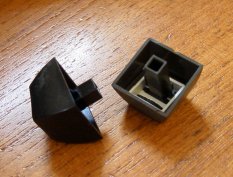PED keyswitch
 | |
| Manufacturer | PED |
|---|---|
| Inventor | Laurence Harry Finlayson |
| Switch type | Tactile |
| Keycap mount | Proprietary hollow square mount |
| Switch mount | Plate mount |
| Patents | EP0043618A1 (1981) |
PED keyswitch is a series of metal contact switches allegedly manufactured by PED[1] and patented by Philips. Designed to support centre illumination, it has only been seen in its non-illuminated form.
Description
The switch is plate-mounted, and has a very plain upper shell. There are no markings of any kind visible. The black shell contains a white slider with a large, square mount that takes a smaller square shaft within the keycap.
The switches have two solder points, and two fixing pins in opposite corners.
Unlike with Hi-Tek Series 725, the contacts do not close when the slider is removed. The contacts are closed under pressure by a funnel within the slider, and the separator bar in the slider holds the contacts apart simply to prevent inadvertent closing such as from impact. The terminals are identical, and the contact prisms are arranged at 45°, which means that they meet at right angles without needing to have opposing contacts with 0° and 90° angles.
The overall height is around 16.3 mm. Height above the mounting plate is around 9.3 mm, with around 6 mm below the plate. The switch is around 15.6 mm square at its widest point. Total travel is difficult to measure, but it is somewhere around 3.2 to 3.5 mm.
The switch is plate mount, but it also features two fixing pins, in opposite corners of the base.
The return spring is around 13.7 mm long with five inner turns, 9.4 mm outer diameter, 8.6 mm inner diameter, and 0.4 mm gauge.
Keyfeel
Because the contacts are pressed together by the slider, the feel is distinctly non-linear, but not tactile in the normally understood sense. The travel starts out linear, up to where the slider starts to press the contacts together; from here on, the switch is noticeably stiffer. The patent specifically describes how the switch design generates tactility, but the feel is not what one would normally classify as a tactile feel, and the effect is comparatively weak.
Keyboards
Gallery
The switches depicted below were sourced from a BBC Micro.
Disassembly
References
- ↑ BBC Micro Mailing List — Subject: Interesting DRAM catalogue





















